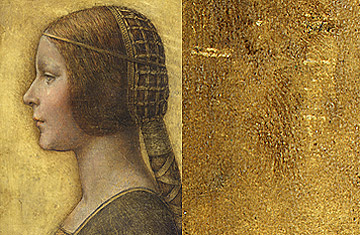
Privately owned painting called La Bella Principessa, thought to be a lost work by Leonardo da Vinci
It's the flip side to the multimillion-dollar counterfeit. The art world is abuzz with the recent discovery that a portrait thought to be the drawing of an unknown 19th century German artist is now being attributed to the Italian master Leonardo da Vinci. And the way the revelation was made is straight out of a Sherlock Holmes novel: researchers traced the portrait to the artist using a 500-year-old fingerprint.
The 13-by-9-inch portrait, which has now been dubbed La Bella Principessa, is a delicate profile of a young aristocratic Milanese woman, drawn with pen, chalk and ink on an animal skin known as vellum. It was bought two years ago by an anonymous Swiss collector at the Ganz Gallery in New York for about $19,000. Experts now put the possible value of the artwork at upwards of $150 million.
The potential fingerprint wasn't a total surprise to everyone, though. Alessandro Vezzosi, a noted da Vinci scholar, stuck out his academic neck last year when he identified the portrait as one of the artist's in his 2008 book, Leonardo Infinito. He based his conclusion on artistic, stylistic and historic considerations. "There is some embarrassment out there," says Vezzosi, director of the Leonardo da Vinci Museum in the artist's hometown of Vinci, Italy. "Just looking at it, you know it isn't German."
The current owner of the portrait also had a hunch. Together with Canadian-born art collector Peter Silverman, who bought the work on his behalf from the Ganz, the owner consulted top art experts who began to accumulate clues that might link the portrait to da Vinci. Specifically, they looked for evidence that the work was created by a left-handed artist (Leonardo was a southpaw), and they explored the artist's connections to the apparent subject of the portrait, the daughter of the 15th century Duke of Milan.
Then one of the experts, Montreal-based art-forensics specialist Peter Paul Biro, discovered the print of an index finger on the top left corner of the drawing using state-of-the-art multispectral infrared technology, according to a report in the Antiques Trade Gazette. Biro says the print was "highly comparable" to another fingerprint found on da Vinci's St. Jerome painting in the Vatican. Carbon dating of the drawing also linked it to da Vinci's period, according to the experts. "The fingerprint is simply a confirmation of what we believed to be true," Vezzosi says. "Like at a crime scene, it is often the sum of the clues that are gathered to arrive at what I call reasonable certainty."
Still, there are those who dispute the finding. Ganz Gallery owner Kate Ganz, who bought the work at a Christie's auction for $17,000 in 1998, had clearly arrived at the conclusion that the piece was not a da Vinci. She held on to it for nine years before selling it to the current Swiss owner for $19,000, identifying it as "made by a German artist studying in Italy ... based on paintings by Leonardo da Vinci." On Tuesday she stuck by her initial evaluation, telling the New York Post, "I do not believe the [drawing] is by Leonardo, and nothing I have read or seen has changed my mind." The Post also reported that Biro was once accused of falsely authenticating a Jackson Pollock painting on the basis of a fingerprint that was allegedly copied off a paint can from the artist's studio. Biro has denied any wrongdoing and has never been charged in the case.
Like Ganz, Christie's is wincing at the revelation, having listed the work at the 1998 auction as "German, early 19th century." The auction house issued a press release saying the "possible attribution of this work [to da Vinci]" relied on "cutting-edge scientific techniques which were not available to us at the time of the sale and which even today are new and unproven." Christie's refused to comment further "until the debate has resolved itself and scholars are all in agreement."
Whether art scholars can come to an agreement on the subject remains to be seen. But Christie's knows all too well that the other way to arrive at a verdict on the work's provenance may be for the mysterious Swiss owner to put it back up for sale. You can bet it wouldn't be listed as "19th century German" or sell for less than $20,000.
